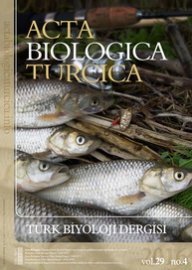Use of Cappadocia Name in Binomial Nomenclature
Abstract
In binominal nomenclature, the second name is the descriptive name, and it is also common use to determine place names to describe the distribution area of the species or the place where it was first identified (type locality). Cappadocia is the name given to a large area in Central Anatolia. In ancient times, a wide area from the Black Sea to the north, Adana to the south, Elazig to the east and Konya to the west was called Cappadocia. History BC Many civilizations ruled in the Cappadocia region, which dates back to 7000 BC, and has been an important area throughout history. For this reason, it has been chosen as the descriptive name of many species. There are 65 taxa belonging to 36 families, which are validly named Cappadocia. They consist of 1 bacteria, 42 (three varieties, six subspecies and 33 species) plants, one fungus, 14 insects (3 subspecies and 8 species), one fish and two reptiles (one species and its subspecies). The most preferred descriptive names are cappadocica (31 taxa), followed by cappadocicum (16 taxa), cappadocicus (10 taxa), cappadocia (three taxa), cappadocius (two taxa), and cappadoca, cappadociae and cappadociensis (one taxon in each). According to the Turkish names of the species, it is seen that the names given by the traditional names are used for some of them. However, peri- and baca- prefixes are used in Turkishized names, referring to the fairy chimneys, which are the symbol of Cappadocia.
Keywords
Full Text:
PDFReferences
Adameros Herptil Türkiye. (2021). Türkiye Kurbağa ve Sürüngenleri Gözlemciliği ve Fotoğrafçılığı Topluluğu, http://www.turkherptil.org/, erişim tarihi 28.09.2021.
Allcock, S.L., & Roberts, N. (2014). Changes in regional settlement patterns in Cappadocia (central Turkey) since the Neolithic: a combined site survey perspective. Anatolian Studies, 64, 33-57.
Aykurt, C., & Sümbül, H. (2014). Taxonomic revision of the genus Convolvulus L. (Convolvulaceae) in Turkey. Biological Diversity and Conservation, 7 (2), 1-28.
Bizim Bitkiler. (2021). Türkçe Bitki Adları. https://www.bizimbitkiler.org.tr/v2/turkce.php, Erişim Tarihi: 11.09.2021.
Çiçek, E., Sungur, S., & Fricke, R. (2020). Freshwater lampreys and fishes of Turkey; a revised and updated annotated checklist 2020. Zootaxa, 4809 (2), 241-270.
Doğan, U., Koçyiğit, A., & Yılmaz, E. (2019). Geomorphological evolutionary history of the Melendiz River Valley, Cappadocia, Turkey. Mediterranean Geoscience Reviews, 1(2), 203-222.
GBIF: The Global Biodiversity Information Facility. (2021). What is GBIF?. Available from https://www.gbif.org/what-is-gbif [29 September 2021]
Gnezdilov, V.M., Holzinger, W.E., & Wilson, M.R. (2014). The Western Palaearctic Issidae (Hemiptera, Fulgoroidea): An Illustrated Checklist And Key To Genera And Subgenera. Proceedings of the Zoological Institute RAS, 318 (Supplement 1), 4-013.
Güner, A., Aslan, S., Ekim, T., Vural, M., & Babaç, M.T. (Editörler.) (2012). Türkiye Bitkileri Listesi (Damarlı Bitkiler). Nezahat Gökyiğit Botanik Bahçesi ve Flora Araştırmaları Derneği Yayını. İstanbul.
Hamzaoğlu, E. Budak, Ü., & Aksoy, A. (2011). A new genus, Turanecio, of the Asteraceae (tribe Senecioneae). Turkish Journal of Botany, 35, 479-508.
Hermann, H., Kurt, H., & Peter, K. (1988). Achter Beitrag zur systematischen Erfassung der Noctuidae der Türkei Beschreibung von sechs neuen Taxa und Notizen über bemerkenswerte Funde aus neueren Aufsammlungen (Lepidoptera). Atalanta, 18, 339-369.
Işık, K., Gençbay, T., Topkara, A.R., Sarıcaoğlu, S., Saygın, H., Ay, H., Çetin, D., Güven, K., & Şahin, N. (2018). Amycolatopsis cappadoca sp. nov., isolated from soil. Antonie Van Leeuwenhoek, 111(7), 1175-1182. doi: 10.1007/s10482-018-1023-y
Kalas, V.G. (2004). Early explorations of Cappadocia and the monastic myth. Byzantine and Modern Greek Studies, 28, 101-119.
Menemen, Y., Aytaç, Z., & Kandemir, A. (2016). Türkçe Bilimsel Bitki Adları Yönergesi. Bağbahçe Bilim Dergisi, 3(3), 1-3.
Onat, G., Yılmaz, D.S., & Karakuş, Y. (2021). Evaluation of Employee Competence by Qualıty Function Deployment Method: The Case of Hotels in Cappadocia. Revista Turismo Estudos e Práticas-RTEP/UERN, 10(2), 1-19.
Özer, S., Skelton, P.W., Tarlao, A., & Tunis, G. (2021). Taxonomic revision of the rudist bivalve genus Joufia Boehm (Hippuritida, Radiolitidae), Upper Cretaceous, Mediterranean Tethys. Cretaceous Research, 118, 104642. https://doi.org/10.1016/j.cretres.2020.104642.
Ride, W.D.L., Cogger, H.G., Dupuis, C., Kraus, O., Minelli, A., Thompson, F.C., & Tubbs, P.K. 1999. International Code of Zoological Nomenclature, 4th edition. xxix, 306 pp. The International Trust for Zoological Nomenclature, London.
Sevgi, O., & Akkemik, Ü. (2014). “Türkiye Bitkileri Listesi (Damarlı Bitkiler)” Adlı Eserin Bilgi Kaynağı ve Terim Yaklaşımı Üzerine Bir Değerlendirme. Avrasya Terim Dergisi, 2(1), 50-67.
Turland, N.J., Wiersema, J.H., Barrie, F.R., Greuter, W., Hawksworth, D.L., Herendeen, P.S., Knapp, S., Kusber, W.-H., Li, D.-Z., Marhold, K., May, T.W., McNeill, J., Monro, A. M., Prado, J., Price, M.J., & Smith, G.F. (eds.) (2018). International Code of Nomenclature for algae, fungi, and plants (Shenzhen Code) adopted by the Nineteenth International Botanical Congress Shenzhen, China, July 2017. Regnum Vegetabile 159. Glashütten: Koeltz Botanical Books. DOI: https://doi.org/10.12705/Code.2018
Zilch, A. (1964). Gottfried Nägele (1841-1914). Arch. Moll., 93(5/6), 263-266.
Refbacks
- There are currently no refbacks.

